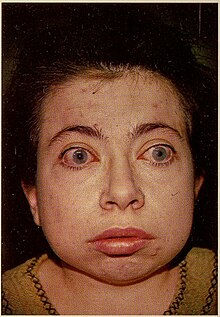| Scheie syndrome | |
|---|---|
| Other names | MPS I-S |
 | |
| Patient with Scheie syndrome | |
| Symptoms | Symptoms are variable, but may include: mild learning disabilities, psychiatric issues, visual problems, skeletal deformities, carpal tunnel syndrome, aortic valve disease, and/or sleep apnea |
| Usual onset | Symptoms may appear by age 5; diagnosis is usually made after age 10 |
| Causes | Deficiency of the alpha-L iduronidase enzyme |
| Differential diagnosis | Other forms of MPS I; Hunter syndrome; other mucopolysaccharidoses |
| Treatment | Enzyme replacement therapy with iduronidase; surgery may be necessary |
| Prognosis | These patients may live to adulthood. |
| Frequency | 1 in 5,000,000[1] |
Scheie syndrome is a disease caused by a deficiency in the enzyme iduronidase, leading to the buildup of glycosaminoglycans (GAGs) in the body. It is the most mild subtype of mucopolysaccharidosis type I; the most severe subtype of this disease is called Hurler Syndrome.
Scheie syndrome is characterized by corneal clouding, facial dysmorphism, and normal lifespan.[2][3] People with this condition may have aortic regurgitation.[4]
- ^ "Mucopolysaccharidoses Fact Sheet". National Institute of Neurological Disorders and Stroke. 15 Nov 2017. Retrieved 11 May 2018.
- ^ Ropper AH, Samuels MA, "Chapter 37. Inherited Metabolic Diseases of the Nervous System" (Chapter). Ropper AH, Samuels MA: Adams and Victor's Principles of Neurology, 9e: http://www.accessmedicine.com/content.aspx?aID=3636356.
- ^ Bonakdar-Pour, Akbar (2010-06-09). Diagnostic Imaging of Musculoskeletal Diseases: A Systematic Approach. Springer. ISBN 9781597453554.
- ^ "Scheie syndrome - National Library of Medicine - PubMed Health". ncbi.nlm.nih.gov. Retrieved 19 January 2014.